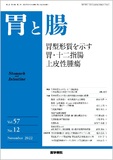Japanese
English
- 有料閲覧
- Abstract 文献概要
- 1ページ目 Look Inside
- 参考文献 Reference
- サイト内被引用 Cited by
要旨●胃癌取扱い規約において,胃型粘液形質を示す胃型腺腫とは幽門腺腺腫(pyloric gland adenoma)を指す.通常,本邦で報告される幽門腺腺腫はH. pyloriによる慢性胃炎を伴う背景粘膜に生じ,H. pylori感染との関連性が高い腫瘍である.しかし近年,H. pylori未感染で胃炎のない正常粘膜にも生じうる腫瘍であることがわかり,H. pylori感染率が低下している本邦において,注目すべき胃腫瘍と思われる.幽門腺由来ではなく胃底腺粘膜に発生し,特に頸部粘液細胞への分化を主体とする腫瘍であるが,同様に胃底腺型細胞へ分化を示す胃底腺粘膜型胃癌などの胃型形質の腫瘍との鑑別が問題となる.本稿では幽門腺腺腫の疾患概要を述べ,症例を提示しながら,その内視鏡所見の読み方・特徴について解説する.
In the Japanese Classification of gastric carcinoma, gastric adenoma with gastric mucin phenotype usually shows gastric PGA(pyloric gland adenoma). PGAs usually occur in the background mucosa of patients with chronic gastritis caused by H. pylori(Helicobacter pylori)infection. Therefore, PGAs observed in Japan are thought to be closely associated with H. pylori. However, in recent years, it has been discovered that it is a tumor that can occur in the normal mucosa uninfected with H. pylori, and it seems to be a notable gastric tumor in Japan where the infection rate of H. pylori is decreasing. Furthermore, PGAs are tumors that occur in the gastric fundic gland mucosa, not from the pyloric gland mucosa, and are mainly differentiated toward mucous neck cells. Therefore, it may be difficult to differentiate it from gastric adenocarcinoma with a gastric phenotype, including gastric adenocarcinoma of fundic gland mucosa type, which has a differentiation toward fundic gland-like cells(oxyntic mucosa). This section describes the disease concept of PGAs and representative cases, and explains how to read the endoscopic findings and their characteristics.

Copyright © 2022, Igaku-Shoin Ltd. All rights reserved.


